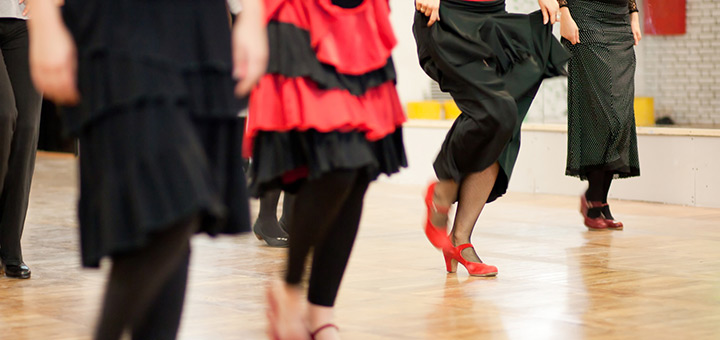The continuing popularity of the BBC’s Strictly Come Dancing has seen many more of us pulling on our dancing shoes.
Dancing is a superb way to have fun, meet new people and improve your fitness levels but us amateurs at dance need to take a few precautions to avoid injury. Dance classes are an excellent way to strengthen and tone muscles, improve posture and flexibility, burn around 500 calories and get a great cardiovascular workout. Like any exercise, you will find that dancing can lift your mood as it releases the feel good hormones endorphins. There are psychological benefits too. In addition to being a great social activity, dancing has been shown (in a scientific study by dance centre Laban) to improve self esteem and motivation levels.
However, professional dancing requires a huge amount of physical effort and the pros really are athletes. In Germany, researchers found that more physical exertion was demanded by a two minute quickstep than by an 800 meter run. Like athletes and sports stars, professional dancers suffer their share of injuries and, whilst their steps might be tricky to reproduce, the injuries are all too easily copied by over enthusiastic social dancers.
The feet and ankles are particularly vulnerable when dancing, as are the lower back and shoulders. Whilst professional dancers suffer from repetitive strain from over use, amateur dancers often suffer acute injuries (sprained ankles) or stiffness from holding their spine and limbs in unusual positions.
Professional dancers commonly use complementary disciplines to help avoid injuries and to heal faster and more fully when they are injured: the dancers at Caesar’s Palace, the famous Las Vegas casino, aren’t allowed on stage without a check-up from their team chiropractor.
If you fancy strutting your stuff on the dance floor it is a good idea to get your spine, posture and joints checked by a chiropractically trained professional first. Your practitioner will check the health of your musculoskeletal frame, joint functioning, strength and flexibility as well as check for how well your nerves are sending messages around your body (essential for painless movement).
It’s important to have such a spinal check up before you start dancing (or commence any new exercise) as you may need advice on your posture, on how to perform certain movements to avoid injury and on specific home exercises you can do to tackle your weaker areas. If you need a chiropractic adjustment to correct misalignments in your skeleton, your practitioner can also discuss this with you and provide the required care.
I would strongly recommend that you find a good dance teacher and take a course of lessons. Ask your teacher about their qualifications and notify them of any conditions or problem areas identified during your spinal check up. Your dance teacher should take you through a series of warm up and stretching exercises (not forgetting to warm up the ankle joints) before you commence dancing and after any break in the dancing. Don’t neglect to repeat the stretches as a cool- down session after your lesson. For more information on good stretches see http://www.spinalcarecentre.co.uk/pages/members/ReliefPhase.html Your dance teacher will be able to give the best advice on appropriate supportive shoes – don’t skimp on these as poor footwear will dramatically increase your risk of injury. Your practitioner will have already examined your foot function and advised on any need for orthotics (shoe inserts) to correct excessive or insufficient rolling of the foot as you walk.
Build up your level of exertion, motion and flexibility gradually. Wear comfortable clothing that does not restrict your movements. Only dance on a floor that has a bit of give and make sure that you drink lots of water to stay hydrated throughout the lesson. Pay particular attention to maintaining a straight but not stiff posture – this will dramatically increase your balance and help avoid back problems.
Look in your local community guides or try http://www.essex.gov.uk/Activities/Arts%20Services/Essex-Dance-Theatre/Pages/Default.aspx a great site for local dance information
The Benefits of Dance:
- Healthier heart and lungs
- Stronger muscles, bones and reduced risk of osteoporosis
- Better coordination, agility and flexibility
- Increased energy expenditure to counteract unwanted weight gain
- Improved general and psychological well-being
- Greater self-confidence and self-esteem
- Improved balance and enhanced spatial awareness
- Increased physical confidence and improved mental functioning
- Increased trust
- Better social skills and reduced social isolation and exclusion

